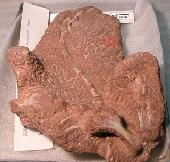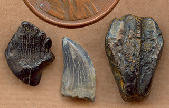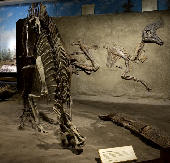|
 See More Images See More Images
(86 total)

Anchisaurus polyzelus
© 2005 Yale Peabody Museum

Ankylosauridae, Dromaeosauridae, Hadrosauridae
© 2005 George E. Phillips, Mississippi Museum of Natural Science

Lambeosaurus
© 2008 Royal Tyrrell Museum
|
What are Reptiles? Familiar reptiles like crocodiles, lizards, turtles, and dinosaurs are all amniotes, as are birds and mammals. All amniotes have embryos that develop within a fluid-filled amniotic sac inside a semi-permeable shell, which together cushion and protect the developing embryo. Amniotes have been divided into three groups based on differences in the number and position of openings in the skull behind the eyes, called temporal fenestrae: the Anapsida with no fenestrae, as in turtles; the Synapsida, which lost the upper fenestra, as in mammals and their relatives; and the Diapsida with two fenestrae, as in dinosaurs, birds, and lizards. The fossil record of reptiles extends back to the Middle Carboniferous. First known fossil occurrence: Carboniferous. Last known fossil occurrence: Quaternary. This group has living relatives. Cool Reptiles links: Search for images of Reptiles on Google |
|





